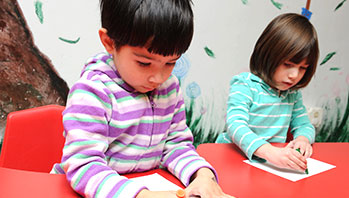- markers
- paper
- Samantha on a Roll (book)
- scissors
- hill
- obstacle
- roll
MA Standards:
English Language Arts/Literature/RL.PK.MA.2: With prompting and support, retell a sequence of events from a story read aloud.
English Language Arts/Writing/W.PK.MA.2: Use a combination of dictating and drawing to explain information about a topic.
Head Start Outcomes:
Literacy Knowledge/Early Writing: Uses scribbles, shapes, pictures, and letters to represent objects, stories, experiences, or ideas.
PreK Learning Guidelines:
English Language Arts/Composition 16: Use their own words or illustrations to describe their experiences, tell imaginative stories, or communicate information about a topic of interest.
English Language Arts/Composition 19: Arrange events in order when dictating a story.
Draw and Write Together: A Story Map

© Commonwealth of Massachusetts, Department of Early Education and Care (Jennifer Waddell photographer). All rights reserved.
ELA Focus Skills: Comprehension, Concepts of Print, Sequencing, Storytelling, Story Structure
Tell children that together they will make a story map to tell the story of Samantha on a Roll. Guide them to understand that a story map lists, or shows, each part of the story in the order it occurs in the book. Explain that the story map will help them recall the events in a story as they retell the story.
As you make the story map, allow children to browse through the book to refresh their memories about the sequence of events.
- Attach the heading “Samantha Skates” at the top of a bulletin board or long wall.
- Cut out a house shape. Attach it at the top left side of the board/wall. Say, This stands for Samantha’s house. This is where the story begins and ends.
- Attach a paper path on the board/wall going up, down, and across, and then curving back to the house. Say, This is the path that Samantha skated.
- Ask, What did Samantha do after she came out of the house? (skated up to the top of Hawthorn Hill) Label Hawthorn Hill at the topmost part of the path; write children’s response in a sentence on the path, e.g., “Samantha skated up Hawthorn Hill.” Draw a simple picture of Samantha on skates.
- Repeat this process as Samantha rolls down the hill, meets people and obstacles along the way, returns home, and the story ends. If children wish to add the tree in which Samantha lands then allow a volunteer to cut a tree out of paper and then have another volunteer attach it to the map.
- “Walk” along the path, pointing to the various comments and pictures as you briefly narrate the story in your own words. Then invite children to do the same.
Adaptation: If very young children have trouble recalling the sequence or retelling the story, guide them to the next major event, point to the picture, and ask, What happened here?
